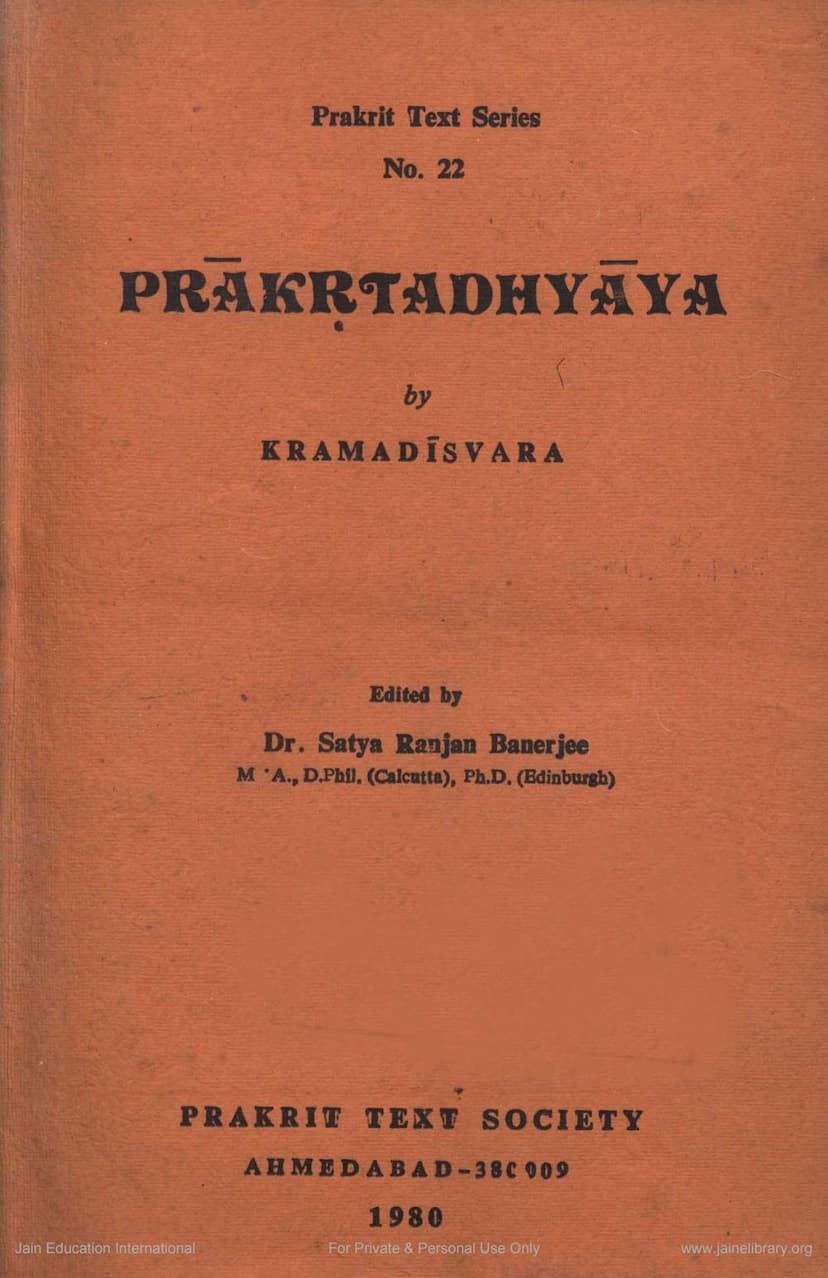Prakritadhyaya
Added to library: September 2, 2025

Summary
Here's a comprehensive summary of the Jain text "Prakritadhyaya" by Kramadisvara, as presented in the provided pages:
Book Title: Prakritadhyaya (The Prakrit Book of the Samkshiptasara) Author: Kramadisvara Editors/Contributors: Satyaranjan Banerjee (Editor), Dalsukh Malvania, H. C. Bhayani Publisher: Prakrit Text Society, Ahmedabad Year: 1980
Overall Purpose and Significance:
This volume presents the "Prakritadhyaya" (Chapter on Prakrit) from Kramadisvara's larger grammatical work, the "Samkshiptasara." The Prakritadhyaya is significant for its coverage of Prakrit grammar, including various dialects and the important Apabhramsa language. This edition, edited by Dr. Satyaranjan Banerjee, is noted as the first to be based on all available manuscripts, aiming for a critical and accurate representation of Kramadisvara's work. The text is valuable for understanding the history and structure of Prakrit languages and for its contribution to the Eastern school of Prakrit grammarians.
Key Content Areas:
The book is structured as a grammatical treatise on Prakrit, covering several key areas:
-
Introduction and Editorial Notes:
- The introductory sections detail the history of scholarly engagement with Kramadisvara's work, highlighting earlier scholars like Lassen, Dalius, and Cowell.
- Dr. Banerjee's editorial process, including the collation of numerous manuscripts (A, B, C, C1, V, S, S1) and comparison with earlier printed editions (L, D, P, P1, P2, P3), is extensively described. The challenges of textual corruption in the manuscripts are emphasized, particularly in the Apabhramsa section.
- The General Editor's foreword and Dr. Banerjee's introduction discuss the value of Kramadisvara's work, its place within the Eastern school of grammar, and the difficulties in establishing a definitive text due to manuscript variations and errors.
- The introduction also includes a detailed biography of Kramadisvara, discussing his appellations, possible contemporary grammarians, his work's circulation, an anecdote about its composition, his parentage, native place, and the influence of commentators like Jumaranandi and Goyicandra.
-
Structure of the Prakritadhyaya: The Prakritadhyaya itself is divided into five chapters:
- Chapter I: Svara-karyam (Vowel Operations): This chapter details the various changes and rules pertaining to vowels in Prakrit, with numerous examples illustrating transformations from Sanskrit.
- Chapter II: Hal-karyam (Consonant Operations): This chapter focuses on the changes and rules related to consonants, including initial, medial, and conjunct consonants, and their transformations.
- Chapter III: Subanta-karyam (Nominal Declension): This section covers the declension of nouns and pronouns in Prakrit, detailing case endings and various forms.
- Chapter IV: Tintanta-karyam (Verbal Conjugation): This chapter explains the conjugation of verbs, including verb roots, tense formation, and various verbal forms.
- Chapter V: Apabhramsa-rambhah (Beginning of Apabhramsa): This is a significant chapter that deals with Apabhramsa, the intermediary language between Prakrit and modern Indo-Aryan languages. It also includes discussions on other Prakrit dialects and sub-dialects.
-
Dialects Discussed: Kramadisvara's work covers several Prakrit dialects, including:
- Maharashtri (as the main Prakrit)
- Magadhi
- Sauraseni (mentioned explicitly and implicitly)
- Paisaci
- Vracaḍa
- Nagara
- Upanagara
- Sabari
- Ardhamagadhi (described as an admixture of Maharashtri and Magadhi)
- Other regional variations are also noted.
-
Key Features of Kramadisvara's Grammar:
- Eastern School Influence: Kramadisvara is a prominent figure in the Eastern school of Prakrit grammarians, and his work reflects their linguistic principles, which often differ from the Western school (e.g., Hemacandra).
- Innovation: While building upon earlier traditions (like Vararuci), Kramadisvara introduced new sutras and discussions, particularly on Apabhramsa, which were not extensively covered by predecessors.
- Practical Approach: The grammar aims to describe the characteristics of Prakrit languages as they were in use, rather than being purely theoretical.
- Conciseness: Despite its comprehensiveness, the "Samkshiptasara" (meaning "condensed essence") aims for a succinct presentation of grammatical rules.
- Inclusion of Apabhramsa: The dedicated chapter on Apabhramsa is a notable feature, providing insights into this crucial stage of language evolution.
- Textual Challenges: The introduction highlights that the available manuscripts contain numerous corruptions and errors, making the task of critical editing challenging. The editor, Dr. Banerjee, discusses these issues extensively in the critical apparatus.
Editorial Contributions:
- Dr. Satyaranjan Banerjee: The primary editor, responsible for the critical edition, collation of manuscripts, textual analysis, and the detailed introductory and critical apparatus sections. His work aims to provide a reliable text of the Prakritadhyaya for the first time.
- Dalsukh Malvania and H. C. Bhayani: Serve as General Editors for the Prakrit Text Society series, overseeing the publication. H. C. Bhayani's foreword provides context and an evaluation of the text and the editorial effort.
Overall Value:
The "Prakritadhyaya" by Kramadisvara, as presented in this edition, is a significant scholarly work for linguists, philologists, and Indologists. It offers a detailed account of Prakrit grammar, contributes to the understanding of the Eastern grammatical tradition, and sheds light on the evolution of Prakrit and Apabhramsa. The critical edition addresses the long-standing need for a reliable text of this important grammatical work.